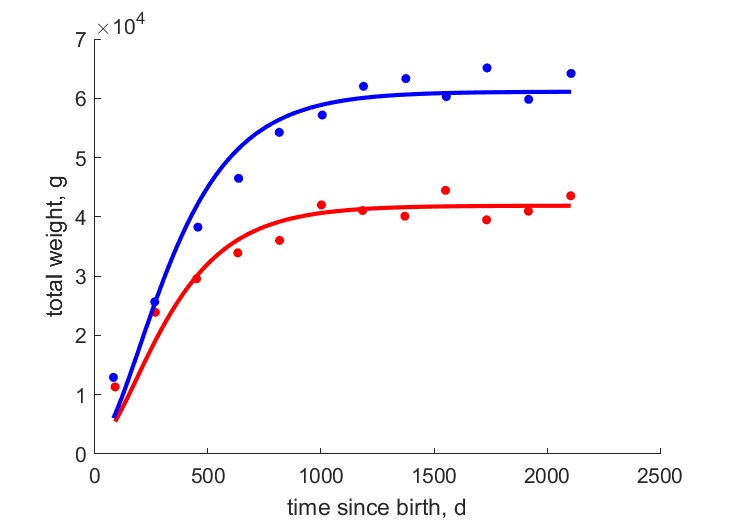Predictions & Data for this entry
| Model: stx | climate: Aw, Cfa, Cfb, Dfa, Dfb, Dwa, Dwb | migrate: | phylum: |
| COMPLETE = 2.5 | ecozone: THp, TPi | food: bxM, xiO | class: |
| MRE = 0.051 | habitat: 0iTf, 0iTh | gender: Dg | order: |
| SMSE = 0.004 | embryo: Tv | reprod: O | family: |
Zero-variate data
| Data | Observed | Predicted | (RE) | Unit | Description | Reference |
|---|---|---|---|---|---|---|
| tg | 115 | 114.8 | (0.001313) | d | gestation time | AnAge |
| tx | 56 | 60.92 | (0.08792) | d | time since birth at weaning | AnAge |
| tp | 334 | 333.1 | (0.002723) | d | time since birth at puberty for female | AnAge |
| am | 9855 | 9813 | (0.00427) | d | life span | AnAge |
| Wwb | 960 | 1003 | (0.04506) | g | wet weight at birth | AnAge |
| Wwx | 5700 | 5296 | (0.07091) | g | wet weight at weaning | AnAge |
| Wwim | 1.3e+05 | 1.334e+05 | (0.02633) | g | ultimate wet weight males | AnAge |
| Ri | 0.03043 | 0.03036 | (0.002431) | #/d | maximum reprod rate | AnAge |
Uni- and bivariate data
| Data | Figure | Independent variable | Dependent variable | (RE) | Reference |
|---|---|---|---|---|---|
| tW_f |   | time since birth | total weight | (0.06379) | DzieClar1990 |
| tW_m |   | time since birth | total weight | (0.05536) | DzieClar1990 |
Pseudo-data at Tref = 20°C
| Data | Generalised animal | Sus scrofa | Unit | Description |
|---|---|---|---|---|
| v | 0.02 | 0.1901 | cm/d | energy conductance |
| p_M | 18 | 30.46 | J/d.cm^3 | vol-spec som maint |
| k_J | 0.002 | 0.002 | 1/d | maturity maint rate coefficient |
| k | 0.3 | 0.514 | - | maintenance ratio |
| kap | 0.8 | 0.9397 | - | allocation fraction to soma |
| kap_G | 0.8 | 0.8016 | - | growth efficiency |
| kap_R | 0.95 | 0.95 | - | reproduction efficiency |
Discussion
- The max weight in New Zealand is small for a wild boar, modelled with low f
- Males are assumend to differ from females by {p_Am} only
- mod_1: males have equal state variables at b, compared to females
Bibliography